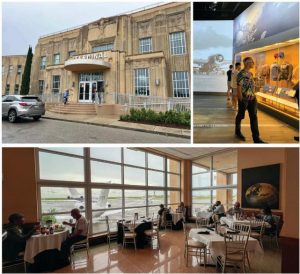Thanks to AOPA Pilot Magazine for featuring this destination profile in its October 2024 issue.

Popping out of the cloud deck at 1,200 feet on final IFR approach into Lakefront Airport (KNEW) in New Orleans, the first thing that may impress you – aside from runway 36L straight ahead – is the water all around it.
It’s no secret that about half of New Orleans is below sea-level, so it should come as no surprise that without some human intervention back in the 1930s, its premier GA airport would have been too. It took the Orleans Levee Board back then to pump in six million yards of hydraulic fill and add 10,000 feet of seawall to raise the field to acceptable levels above Lake Pontchartrain. That engineering feat, and the jaw-dropping Art Deco terminal building, drew 10,000 people to the airport’s opening dedication in 1934.
Celebrating the Golden Age of Aviation
It was an airport ahead of its time. The largest and most modern air terminal in the US, the facility encompassed a post office, hospital, outdoor swimming pool, dining room and commercial kitchen. Private sleeping quarters and baths provided convenient respites for Immigration and Customs officers. Amelia Earhart was a frequent patron, spending a night in the airport’s hotel enroute to her final flight.
But it was the interior and exterior finish out that earned accolades from the flying and general public alike. The Art Deco façade elements, like the “Spirit of Aviation” figure over the entrance, teased guests to what they would discover inside. The extravagant interior incorporated five types of Spanish marble, multi-colored terrazzo and an inlaid brass compass in the main lobby floors. Travertine stair treads and aluminum Art Deco railings led visitors to the mezzanine balcony for a closer look at the painted tile coffered ceilings and massive molded glass custom light fixtures. The Levee District commissioned renowned artist Xavier Gonzalez to paint eight murals to encircle the second-floor atrium, each depicting an historic flight corresponding to the compass rose in the floor below.
Salvaging History
All that was almost lost in the ‘60s during the Cuban Missile Crisis, when the terminal became a bomb shelter and its stunning Art Deco exterior covered by thick concrete panels. Inside, the stunning balcony was covered by a false floor, offices replaced the atrium, and many of Gonzalez’ murals were covered. Were it not for another crisis – this one the destruction and flooding left behind by Hurricane Katrina in 2005 – this story might still be one in the past tense.
It was when FEMA officials came in to assess Katrina’s damage that the Art Deco features were discovered beneath the flooded terminal’s concrete walls. It took a few years, and the work of more than 80 architects and restorationists, to bring the airport’s former glory back to life. They worked from original drawings and benefitted from architect T. Sellers Meric’s thoughtful preservation of the art beneath the cement encasement decades earlier.
No Really. This is the Destination.
Today, the destination may be New Orleans for the pilots and passengers of the 200 or so aircraft using Lakefront daily. But it doesn’t take long to realize that this rejuvenated jewel of an airport is as much a destination as the destination itself.
Not many general aviation reliever airports can boast the walnut paneling, marble wainscoting, coffered ceilings, or plaster motifs that greet visitors to Lakefront. A guest book in the terminal’s lobby is testament to Lakefront Airport’s draw as a tourist attraction; recent guests hail from as far away as Italy, Germany, and Hawaii. Even locals make this a go-to spot, choosing Lakefront to host high school proms, wedding receptions, birthdays, and more.
Meander up the curved travertine staircase to ogle the historic murals like “Flight Over Egypt” and “Flight Over Rio.” Mosey back downstairs and grab a table at Messina’s at the Terminal, where you can nosh on New Orleans fare in a vintage setting while watching the comings and goings on the ramp just outside. The walls of airport aviation director Bruce Martin are lined with posters from at least a dozen Hollywood productions filmed here. Among them: the James Bond film Live and Let Die; the Green Lantern with Reynolds and Blake Lively; Capone starring Tom Hardy; and Hugh Jackman’s Reminiscence.



Blog / November 13, 2023
Magnificent Moab: Southeast Utah's Mecca for Outdoor Adventure